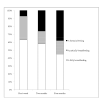Women's breastfeeding experiences following a significant primary postpartum haemorrhage: A multicentre cohort study
- PMID: 20504372
- PMCID: PMC2889881
- DOI: 10.1186/1746-4358-5-5
Women's breastfeeding experiences following a significant primary postpartum haemorrhage: A multicentre cohort study
Abstract
Background: Postpartum haemorrhage (PPH) is a significant and increasing contributor to maternal mortality and morbidity. Following a PPH, women may have difficulties initiating and sustaining breastfeeding, although little has been published on this issue. The aim of this study was to describe breastfeeding experiences in a cohort of women following a significant PPH.
Methods: This is a descriptive study based on quantitative and qualitative data collected via questionnaires completed in the first week postpartum and at two and four months postpartum, by 206 women participating in a multicentre study of women's experiences of a significant primary postpartum haemorrhage (blood loss of 1500 mL or more in the 24 hours following childbirth, and/or a peripartum fall in haemoglobin (Hb) concentration to 7g/dL or less, or of >/= 4g/dL).
Results: Among women with a significant PPH, 63% fully breastfed their babies from birth, whereas 85% said they had hoped to do so (p < 0.001). Only 52% of mothers who intended to either fully or partially breastfeed were able to give their baby the opportunity to suckle within an hour of the birth. Delays were longer in women with greater estimated blood loss and women with the longest delays in breastfeeding were less likely to initiate full breastfeeding. 70% of women with PPH of < 2000 mL were fully breastfeeding in the first postpartum week, whereas less than 50% of those with blood loss >/= 3000 mL were able to do so. Overall, 58% of women with significant PPH were fully breastfeeding at two and 45% at four months postpartum.In qualitative data, three major themes were identified: 1) Difficulty initiating or sustaining breastfeeding, 2) Need for education and support; and 3) Emotional sequelae.
Conclusions: Following a significant PPH, women with greater blood loss are less likely to initiate and sustain full breastfeeding and this may be related, in part, to delays in initial contact with their baby as a consequence of the PPH. These findings have implications for postnatal care as these women may require greater support, education and assistance in initiating and sustaining breastfeeding. In particular, enabling the opportunity for the newborn to suckle as soon as is practicable should be encouraged.
Figures





References
-
- Joseph KS, Rouleau J, Kramer MS, Young DC, Liston RM, Baskett TF. for the Maternal Health Study Group of the Canadian Perinatal Surveillance System. Investigation of an increase in postpartum haemorrhage in Canada. British Journal of Obstetrics and Gynaecology. 2007;114:751–759. - PubMed
-
- Lewis G, (ed) The Confidential Enquiry into Maternal and Child Health (CEMACH). Saving Mothers' Lives - Reviewing maternal deaths to make motherhood safer 2003-2005.The Seventh Report on Confidential Enquiries into Maternal Deaths in the United Kingdom. London: CEMACH; 2007.
LinkOut - more resources
Full Text Sources

